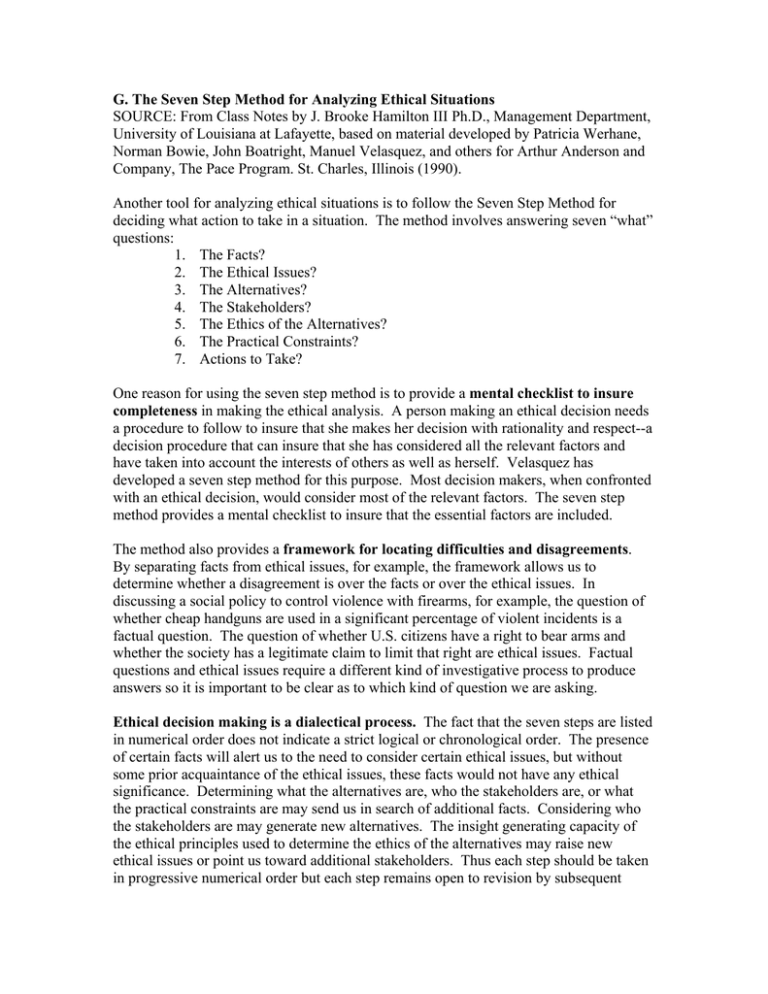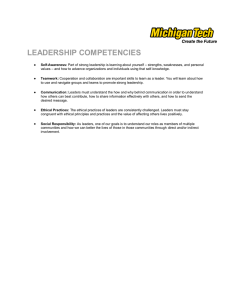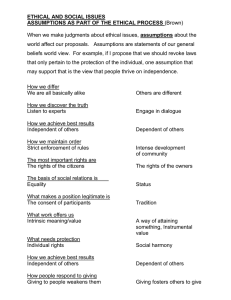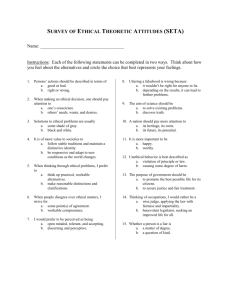Model G - The Seven Step Method for Analyzing Ethical Situations
advertisement

G. The Seven Step Method for Analyzing Ethical Situations SOURCE: From Class Notes by J. Brooke Hamilton III Ph.D., Management Department, University of Louisiana at Lafayette, based on material developed by Patricia Werhane, Norman Bowie, John Boatright, Manuel Velasquez, and others for Arthur Anderson and Company, The Pace Program. St. Charles, Illinois (1990). Another tool for analyzing ethical situations is to follow the Seven Step Method for deciding what action to take in a situation. The method involves answering seven “what” questions: 1. The Facts? 2. The Ethical Issues? 3. The Alternatives? 4. The Stakeholders? 5. The Ethics of the Alternatives? 6. The Practical Constraints? 7. Actions to Take? One reason for using the seven step method is to provide a mental checklist to insure completeness in making the ethical analysis. A person making an ethical decision needs a procedure to follow to insure that she makes her decision with rationality and respect--a decision procedure that can insure that she has considered all the relevant factors and have taken into account the interests of others as well as herself. Velasquez has developed a seven step method for this purpose. Most decision makers, when confronted with an ethical decision, would consider most of the relevant factors. The seven step method provides a mental checklist to insure that the essential factors are included. The method also provides a framework for locating difficulties and disagreements. By separating facts from ethical issues, for example, the framework allows us to determine whether a disagreement is over the facts or over the ethical issues. In discussing a social policy to control violence with firearms, for example, the question of whether cheap handguns are used in a significant percentage of violent incidents is a factual question. The question of whether U.S. citizens have a right to bear arms and whether the society has a legitimate claim to limit that right are ethical issues. Factual questions and ethical issues require a different kind of investigative process to produce answers so it is important to be clear as to which kind of question we are asking. Ethical decision making is a dialectical process. The fact that the seven steps are listed in numerical order does not indicate a strict logical or chronological order. The presence of certain facts will alert us to the need to consider certain ethical issues, but without some prior acquaintance of the ethical issues, these facts would not have any ethical significance. Determining what the alternatives are, who the stakeholders are, or what the practical constraints are may send us in search of additional facts. Considering who the stakeholders are may generate new alternatives. The insight generating capacity of the ethical principles used to determine the ethics of the alternatives may raise new ethical issues or point us toward additional stakeholders. Thus each step should be taken in progressive numerical order but each step remains open to revision by subsequent steps. The steps are related in a dialectical way in that the completion of one leads us to see inadequacies in previous steps that need revision. The requirement to decide on a real time response to the situation sets a limit on how much of this dialectical thinking we can engage in. The proper response to a competitor’s marketing program may allow very little time for consideration whereas a decision on an affirmative action hiring policy may allow quite a bit of time for consideration and revision. A Description of the Seven Steps The following example will be used in describing the seven steps: Stern Products, Inc. has for the past 30 years paid the entire cost of health coverage for workers and their dependents. Recent increases in health insurance premiums on the order of 25% per year have made this coverage a significant cost item on the firm's income statement. The three members of the compensation committee are directed to review the health coverage policy and make recommendations at the next board meeting. 1. The Facts? a. What facts make this an ethical situation? What are the significant features of the particular situation which make it an ethical situation? Is there some actual or potential harm involved for an individual or group? Does the situation relate to some basic human goods which are being created, distributed, denied or threatened? Does the situation affect human welfare in some significant way? Does it involve considerations of justice or rights? Health coverage for workers involves deciding how to divide up the goods of the corporation which is not only an economic question of how to maximize the value of the firm but an ethical question of what is the best distribution, the most just distribution, or the distribution which fulfills each groups rightful claims on the value of the firm. b. What facts are relevant to making an ethical decision? What facts should we know in order to decide how to act in this situation? Steps 1 and 2 are closely related. What facts are relevant will depend on what the ethical issues are and the ethical issues will be determined by the presence of certain facts. Thus the initial assessment of facts will have to be augmented once the ethical issues have been determined. The facts in the Stern case would include: the cost to the company of the various coverage options, the short and long term economic prospects for the firm, worker demographics such as age, health status, level of economic sophistication, availability and cost of individual coverage, the effects of a change or lack of a change in coverage on the employees and the firm. 2. The Ethical Issues? a. What level of ethical issues are we dealing with: systemic, corporate, or individual? Knowing the level of the problem will help us to decide who will be affected by the decision and will therefore qualify as stakeholders and who will be required to make the decision--the society as a whole, decision makers within the corporation, or myself as an individual. The Stern case involves corporate level issues, though reflecting on the high number of uninsured persons in the society and how that impacts on the corporation's cost of coverage may prompt the firm to get involved with the issue on an systemic level. b. What specific ethical issues does this situation raise? Is it a question of how to maximize benefits and minimize harms. Is it a question of whether an action can be universalized? Of whether individuals are being treated as ends and not merely as means? Of whether all rational persons would agree that a particular action is right or good? Is it a question of a possible violation of rights or a conflict between rights? Is it a question of the fair distribution of benefits and burdens? Is it a question of how or whether to apply some specific ethical principle? The ethical issues could be stated as follows: (1) What level of health coverage do employees have a right to expect, given the history of the company? (2) What level of coverage will maximize worker productivity while contributing the most to the profitability of the firm? (3) Should the firm involve itself in the national debate on health care coverage? c. What level of generality is required? The ethical issues need to be stated at a level of generality which will allow the issue to be discussed in as broad a terms as possible, so as to see all the possible ramifications, while yet being specific enough to lead to alternative actions in the case at hand. The issue of health benefits for a corporation's employees should allow reference to the standards of the society as a whole but should refer to a decision to be made by this particular corporation. 3. The Alternatives? Given the facts and the ethical issues, what alternative actions are possible in this situation? Initially we should state as many alternatives as possible without making judgments as to their plausibility. Having generated as many as possible, the most plausible should be chosen for further examination. The corporation can provide no health benefits, co-pay with the employee, provide full benefits for the employee only, provide family benefits, open an HMO, and so on. 4. The Stakeholders? a. Who will be affected by the alternatives and to what degree? We must determine who will be affected to a degree significant enough to include them among the primary stakeholders worthy of consideration. For systemic issues, which individuals, groups, institutions, and aspects of the physical, economic and social environment will be affected. For corporate issues, who and what inside and outside the corporation will be affected: stockholders, government, society, the environment, suppliers, customers, local community, employees, managers and so on. For individual issues, who will be affected by the decision, both inside the company such as peers, superiors, other departments, and outside the company such as customers and suppliers. In the health care example, the stakeholders include the corporation as a viable economic entity, the stockholders, the employees, their families and the local community. b. How to rank stakeholder claims? Part of the decision making process will be to establish how much weight each stakeholder's claim deserves. This weighing of claims is often done intuitively. For purposes of justifying why the decision is the right one, however, the process for weighing the competing claims should be spelled out as much as possible. c. The firm's claim on resources in order to continue as a viable economic unit would have be given the greatest weight, since without the firm none of the other stakeholders could receive any benefit. The competing claims of stockholders and workers would have to be given the next greatest weight since they contribute directly to the value of the firm and have legitimate claims on that value. Deciding on how much weight to give each group's claims would require and understanding of the capital structure of the firm (debt-equity balance, availability and relative cost of debt financing, and so on) and the history of the firm's relations with the employees (degree of worker contribution to finished product, loyalty and productivity of workers, average length of employment and rate of turnover, and so on). Families and the community would have less weight unless they have made equally important contributions to the firm. 5. The Ethics of the Alternatives? a. Use ethical principles to decide on the best alternative. The ethics of each of the most plausible alternatives is assessed using ethical principles or rules. For each alternative, for example, we could ask the questions associated with the utilitarian, rights and justice principles to determine how the alternative is rated by each theory. When the alternatives have all been rated as right or wrong, good or bad, the object is to select the best alternative. In the ideal situation, all the ethical principles will point to the same alternative as the best one. Utilitarian Principle: Given the relative importance of the firm, the stockholders and the employees, which alternative would provide the greatest benefit to the greatest number? How would costs and benefits be measured in this case? Rights Principle: What does each stakeholder have a right to expect with regard to health coverage? What alternatives would you not want imposed on you if you were in the position of any of the other stakeholders? Justice Principle: Which alternative distributes the burdens and benefits most fairly among the stakeholders? Which stakeholders carry the greatest burden under each alternative? b. How to decide when the theories point to different alternatives. There are situations in which different ethical principles will recommend different alternatives. In a case where the principles provide a mixed recommendation, we must choose which recommendation to follow and be prepared to justify that choice as best we can. Justification can be provided by showing why the theory(ies) indicates that alternative as the best and how this fits better into our conception of what the good life is than the alternatives suggested by the other theories. It may come down to the simple fact that, after inspecting all the alternatives with rationality and respect, I just do value one alternative, or one theoretical approach, or one point of view as highlighted by one theoretical approach, or one state of affairs provided by that alternative, or one value embodied by one alternative more than the others. I may not be able to say why I prefer that alternative except in terms of the way I choose to live my life and what my experience has shown me. Does the fact that I do not have another definite standard to appeal to, if two ethical theories should disagree mean that my decision is irrational or unjustified? The decision is rational in that I have made it on the basis of the careful consideration required by the seven step method and it is justified by showing why it is the best alternative according to at least one ethical theory. To say that I am willing to live by the decision is the only remaining justification. 6. The Practical Constraints? a. Can the best alternative be put into effect? Having decided on one alternative, we need to see whether there are any practical constraints which might prevent that alternative from being acted upon. When practical constraints rule out an alternative, we must return to Step 5 to select the next best alternative and subject it to the practical constraints test. The best alternative may be to pay employees the maximum practicable wages and let them provide for their own health benefits. There may be a state or federal law mandating some level of company provided health coverage which would prevent our adopting this alternative. b. Distinguish ethical from practical constraints. Ethical decision making involves ruling out alternatives on ethical grounds in Step 5 and on practical grounds in Step 6. In actual practice we often do not bother to distinguish the two different kinds of reasons for rejecting an alternative. It is be helpful to keep them distinct as far as possible in order to be clear as to what kind of reason we are giving. The difference between practical constraints and ethical considerations can best be illustrated by example. In deciding on the level of health coverage from a rights perspective, we would weigh the competing rights of employees and the stockholders to the benefits of the company's operations. This ethical consideration would be different, however, from asking the question of whether the stockholders or the workers would agree to accept a particular division of the benefits. 7. Actions to Take? a. Implementing the best alternative. Having selected the best alternative which is not ruled out by practical constraints, we need to decide on the steps necessary to carry it out. If a larger co-payment by employees is the best alternative, how will it be implemented? a. A summary of the justification. We should also be prepared, at the close of this decision process, to provide a justification of why this course of action is the right or good one in this situation. Going through the seven steps justifies the decision in the fullest sense. We should be prepared, however, to respond in some briefer form to the legitimate requests of others--our superiors, our peers, the agents of society--for an explanation of why this alternative is the best approach to this situation. This summary based on the seven steps will also provide us with a briefer account to apply to similar situations in the future. The worst punishment would be to face the full seven step process for each and every ethical decision we make in our lives. We would have no time for living.



